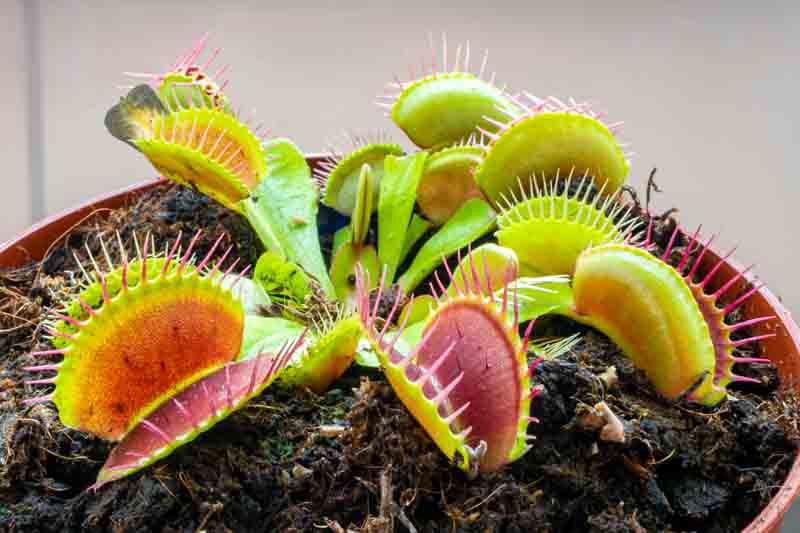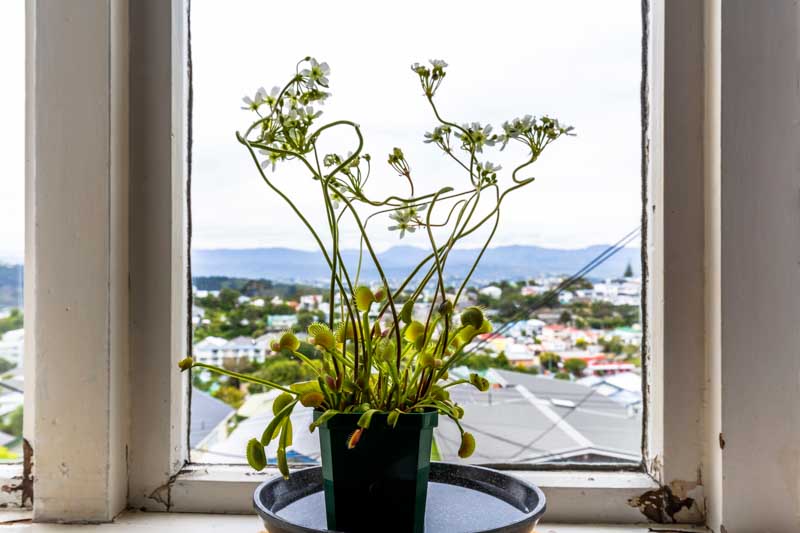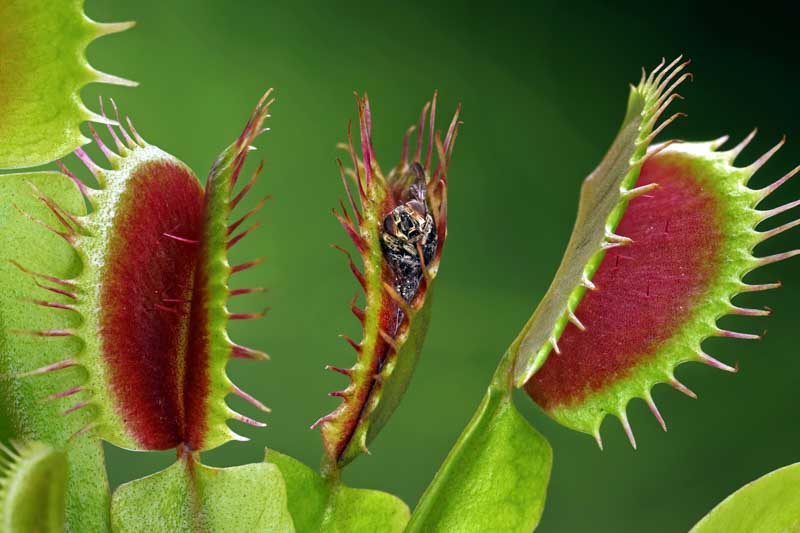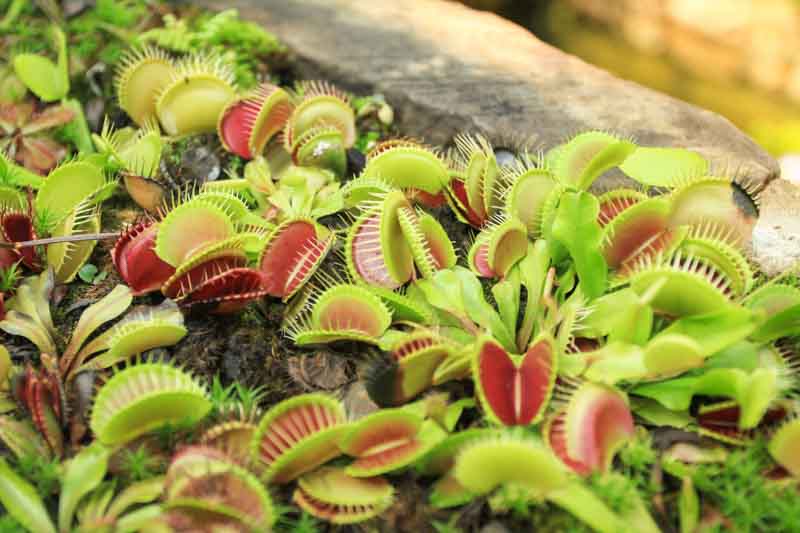Meadow Clams, Venus Flytrap, Venus Fly Trap
Dionaea muscipula, commonly known as the Venus Fly Trap or Venus Flytrap, is one of the most fascinating plants in the botanical world, famous for its unique method of catching prey. This carnivorous plant has captivated interest due to its specialized leaves that snap shut to trap insects.
The Venus Fly Trap features a rosette of leaves, each divided into two main parts: a flat, heart-shaped petiole and a pair of terminal lobes hinged along the midrib, forming the trap. These lobes snap shut when sensitive hairs on their inner surfaces are touched, trapping prey inside.
Native: This plant is native to subtropical wetlands on the East Coast of the United States, particularly in North and South Carolina. Venus Fly Trap thrives in nutrient-poor, acidic soils, where it has adapted to supplement its diet with insects. It belongs to the sundew family (Droseraceae), a family of carnivorous flowering plants that consists of approximately 180 species.
Plant Type and Habit: The Venus Fly Trap is a small, evergreen, insectivorous perennial. It grows from a rhizome and produces a rosette of up to 8 insect-catching leaves. These leaves, or “traps,” split into two hinged lobes lined with bristly margins. Nectar within the plant entices insects towards the trap. Equipped with three sensitive trigger hairs per lobe, the trap snaps shut when an insect disturbs these hairs, securely trapping the prey. The captive insect is then digested over 4-10 days as the plant secretes enzymes, after which the trap reopens, ready for its next victim.
Size: The Venus Fly Trap typically grows to 6-12 inches (15-30 cm) in height and 6-8 (15-20 cm) inches in spread. However, the size can vary based on growing conditions and care.
Flowers: It blooms in late spring or early summer, producing umbels of 4-10 cup-shaped, white flowers on stalks that rise well above the leaves, ensuring pollinators don’t trigger the traps. The flowers give way to small, black seeds that can be used for propagation.
Foliage: The most distinctive feature is its bi-lobed traps edged with spiky appendages resembling jaws. These are green with red interior patches to attract prey.
Hardiness: The Venus Fly Trap is hardy in USDA zones 6-10.
Uses: Primarily grown as an ornamental plant, it’s a popular choice for bog gardens, rain gardens, water gardens, terrariums, and as a fascinating houseplant.
Toxicity: It’s not toxic to humans or pets, but it’s not edible and should not be ingested.
Invasiveness: Dionaea muscipula is not considered invasive. Its growth is naturally limited to specific environmental conditions found in its native habitat. As a matter of fact, the Venus Fly Trap is listed as an endangered species due to habitat loss, poaching, and the destruction of wetlands. Conservation efforts are in place to protect this unique species in its natural habitat. It cannot be legally collected from the wild.

Growing a Venus Fly Trap indoors and outdoors can be a rewarding experience if you replicate its native, nutrient-poor, moist, and acidic soil conditions.
Light: Venus Fly Traps require bright, direct sunlight for about 4-6 hours daily. A south-facing window is ideal. If natural sunlight is insufficient, use a grow light to provide the necessary intensity.
Water: Use distilled water, rainwater, or reverse osmosis water to keep the soil consistently moist. Avoid tap water as the minerals can harm the plant. The pot should be placed in a tray of water to allow the plant to absorb moisture from the bottom.
Soil: Plant in a mixture of sphagnum peat moss and perlite or sand (no fertilizers or compost) to mimic the acidic and nutrient-poor soil of its natural habitat.
Humidity: Maintain high humidity around the plant, above 50%. A humidifier or a tray filled with pebbles and water can help increase ambient humidity.
Temperature: Ideal temperatures range from 70°F to 95°F (21°C to 35°C) during the day and no lower than 55°F (13°C) at night.
Location: In USDA zones 6-10, Venus Fly Traps can be grown outdoors year-round. Choose a spot that receives full sun for most of the day.
Soil: As indoors, use a mix of sphagnum peat moss and perlite or sand. Ensure the planting site or container has excellent drainage.
Water: Keep the soil moist at all times. During dry periods, water regularly to maintain soil moisture.
Winter Care: In areas with mild winters, mulch around the plant to protect it from cold. In colder zones, bring the plant indoors or provide a cold but frost-free environment for dormancy.
Feeding: Venus Fly Traps catch their food, so there’s no need to fertilize. You can feed them small insects if they are indoors and not catching enough on their own. Do not overfeed; once a month is sufficient.
Dormancy: Venus Fly Traps require a winter dormancy period of about 3-4 months with cooler temperatures (35°F to 50°F or 2°C to 10°C) and reduced light. This is crucial for their health and vigor.
Repotting: Repot every 2-3 years in early spring to refresh the soil. Be gentle with the roots to avoid damage.

Propagating Venus Fly Trap can be done through several methods, including division, leaf cuttings, and seeds. Each method has its steps and considerations:
The most straightforward way to propagate Venus Fly Traps is by division, which is best done in early spring or late winter during repotting.
Gently Remove the Plant: Carefully take the plant out of its pot and gently remove the soil around the roots to expose the rhizome.
Identify Divisions: Look for natural divisions in the rhizome where the plant has formed distinct clusters or “bulbs” with their traps.
Separate the Divisions: Using a clean, sharp knife or simply by gently pulling them apart, separate the divisions, making sure each has at least one growing point (trap).
Repot: Plant each division in its pot filled with the appropriate carnivorous plant soil mix (usually sphagnum peat moss and perlite).
Water: Keep the newly potted divisions moist and place them in a location with bright, indirect light.
While not as commonly used or as successful as division, leaf cuttings can sometimes be used for propagation.
Cut a Leaf: Select a healthy, mature leaf and cut it at the base near the rhizome.
Prepare the Cutting: Place the leaf, trap part up, on moist sphagnum peat moss in a small pot or tray.
Maintain Humidity: Cover the pot with plastic wrap or place it in a plastic bag to maintain high humidity, ensuring the soil stays moist but not waterlogged.
Wait for Growth: If successful, a new plantlet will form at the base of the cutting. This process can take several months.
Venus Fly Traps can also be grown from seeds, though this method is the most time-consuming.
Collect Seeds: After the flowers have been pollinated, the plant will produce seed pods. Once they dry and open, collect the seeds.
Sow Seeds: Sow the seeds on the surface of a moist sphagnum peat and perlite mix. Do not cover the seeds with soil, as they need light to germinate.
Maintain Conditions: Keep the soil moist and in bright, indirect light. Covering the seed tray with plastic wrap can help maintain humidity.
Germination: Seeds typically germinate within 4-6 weeks. Keep the seedlings in a bright location and maintain moisture.

The Venus Fly Trap is generally easy to care for, but like all plants, it can encounter pests, diseases, and common problems.
Spider Mites: Indicated by fine webbing on the plant and discolored leaves. Increase humidity around the plant and use a miticide if necessary.
Aphids: These small, sap-sucking pests can cluster on new growth and under leaves. Wash them off with a strong jet of water or treat with insecticidal soap.
Crown Rot: Overwatering can lead to fungal infections at the base of the plant, causing rot. Ensure proper drainage and avoid waterlogging. Affected plants may need to be discarded.
Mold: High humidity with poor air circulation can lead to mold growth on the soil surface or plant. Improve air circulation and reduce humidity around the plant.
Trap Not Closing: This can occur if the plant is overfed, the traps are triggered too often without catching prey, or due to old age of the trap. Ensure natural feeding conditions and avoid manually triggering the traps.
Blackening of Traps: Traps naturally die back after digesting a few insects or if damaged. This is normal, and new growth should replace old traps. If the entire plant is blackening, assess for root rot or crown rot.
No Dormancy: Venus Flytraps require a period of winter dormancy to thrive. Without it, plants may appear weak and stop producing new traps. Provide a dormancy period by placing the plant in a cool (35-50°F or 2-10°C), bright location for 3-4 months in winter.
Poor Water Quality: Tap water with high mineral content can harm Venus Flytraps. Use rainwater, distilled water, or reverse osmosis water instead.
Lack of Sunlight: Insufficient light can lead to weak growth and fewer traps. Ensure your plant receives enough bright, indirect light or supplement with grow lights.

Moderate Difficulty: They require specific conditions including acidic soil, high humidity, pure water (rainwater, distilled, or reverse osmosis), full sunlight, and a dormancy period in winter. Meeting these conditions can be more demanding than caring for typical houseplants.
Not Recommended: While touching the traps occasionally won’t immediately kill the plant, frequently triggering them can weaken and eventually kill the trap. The traps use energy to close, and without the reward of nutrients from digested insects, they can become exhausted and die.
Catches Prey: The Venus Flytrap’s leaves form specialized traps that snap shut when the sensitive hairs inside are touched, trapping insects. It then secretes digestive enzymes to break down and absorb nutrients from its prey, supplementing the poor mineral nutrition of its environment.
Yes and No: While they can benefit from the nutrients obtained from digesting insects, Venus Flytraps can survive without catching prey, as long as they are otherwise properly cared for. However, feeding them occasionally can help maintain a healthy plant.
Yes, But: You can feed a Venus Flytrap dead insects; however, the trap needs to be manually stimulated to close and start the digestion process since the dead insect won’t trigger the hairs inside the trap. Gently rubbing the trap after placing the insect inside can mimic the movement of live prey.
Yes: Venus Flytraps can “eat” dead bugs if they are placed inside the trap and the trap is manually stimulated. The plant will digest the insect in the same way it digests live prey, absorbing nutrients from it.
| Hardiness |
6 - 10 |
|---|---|
| Plant Type | Houseplants, Perennials |
| Plant Family | Droseraceae |
| Exposure | Full Sun, Partial Sun |
| Season of Interest |
Spring (Early, Mid, Late) Summer (Early, Mid, Late) Fall Winter |
| Height |
6" - 1' (15cm - 30cm) |
| Spread |
6" - 8" (15cm - 20cm) |
| Spacing |
6" - 8" (15cm - 20cm) |
| Maintenance | High |
| Water Needs | High |
| Soil Type | Loam, Sand |
| Soil pH | Acid |
| Soil Drainage | Moist but Well-Drained |
| Characteristics | Showy, Evergreen |
| Native Plants | United States, Delaware, New Jersey, Northeast, Southeast, North Carolina, South Carolina, Florida |
| Tolerance | Wet Soil |
| Attracts | Bees |
| Garden Uses | Bog Gardens, Patio And Containers, Rain Gardens, Water Gardens |
| Hardiness |
6 - 10 |
|---|---|
| Plant Type | Houseplants, Perennials |
| Plant Family | Droseraceae |
| Exposure | Full Sun, Partial Sun |
| Season of Interest |
Spring (Early, Mid, Late) Summer (Early, Mid, Late) Fall Winter |
| Height |
6" - 1' (15cm - 30cm) |
| Spread |
6" - 8" (15cm - 20cm) |
| Spacing |
6" - 8" (15cm - 20cm) |
| Maintenance | High |
| Water Needs | High |
| Soil Type | Loam, Sand |
| Soil pH | Acid |
| Soil Drainage | Moist but Well-Drained |
| Characteristics | Showy, Evergreen |
| Native Plants | United States, Delaware, New Jersey, Northeast, Southeast, North Carolina, South Carolina, Florida |
| Tolerance | Wet Soil |
| Attracts | Bees |
| Garden Uses | Bog Gardens, Patio And Containers, Rain Gardens, Water Gardens |
How many Dionaea muscipula (Venus Fly Trap) do I need for my garden?
| Plant | Quantity | |
|---|---|---|
| Dionaea muscipula (Venus Fly Trap) | N/A | Buy Plants |
Create a membership account to save your garden designs and to view them on any device.
Becoming a contributing member of Gardenia is easy and can be done in just a few minutes. If you provide us with your name, email address and the payment of a modest $25 annual membership fee, you will become a full member, enabling you to design and save up to 25 of your garden design ideas.
Join now and start creating your dream garden!
Create a membership account to save your garden designs and to view them on any device.
Becoming a contributing member of Gardenia is easy and can be done in just a few minutes. If you provide us with your name, email address and the payment of a modest $25 annual membership fee, you will become a full member, enabling you to design and save up to 25 of your garden design ideas.
Join now and start creating your dream garden!